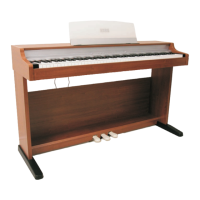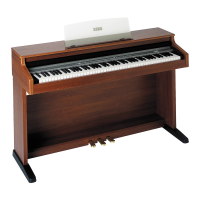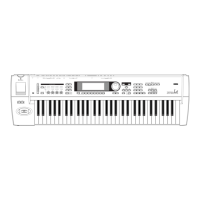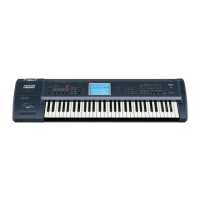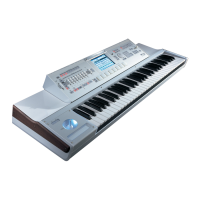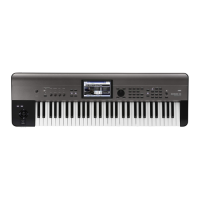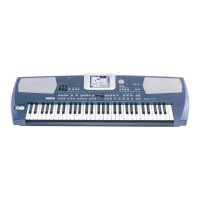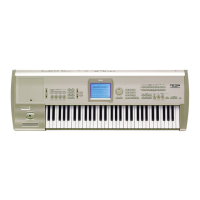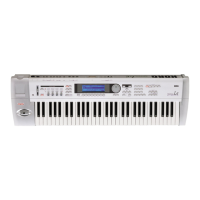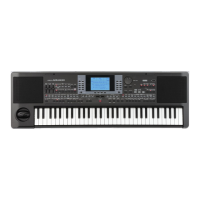Do you have a question about the Korg EK-50 and is the answer not in the manual?
Details the included manuals and explains the conventions used throughout the document.
Explains how to select and play various instrument sounds on the EK-50.
Guides users on playing along with the EK-50's auto-accompaniment styles.
Instructions on playing back audio files from a USB flash drive.
How to connect external audio devices for playback through the EK-50.
Information on adding effects and embellishments to enhance the sound.
Identifies and describes the components located on the front panel of the EK-50.
Identifies and describes the components located on the rear panel of the EK-50.
Describes the lists for styles, songs, and keyboard sets on the control panel.
Explains the function of mode selection and other key operational buttons.
Details buttons related to musical performance like tempo, harmony, and split.
Covers the dial, numerical buttons, and category buttons for selection and value adjustment.
Explains buttons for managing set lists, styles, songs, and parts.
Describes indicators for tempo, beat, and measure position on the display.
Explains display elements for chords, banks, split points, and keyboard activity.
Details indicators for USB connection status and battery level.
Describes how the display changes based on the selected mode (Style, Song, etc.).
Instructions on connecting and using the AC adapter for power.
Guidance on installing, replacing, and using batteries for instrument power.
Steps for turning the instrument's power on and off correctly.
How to adjust the overall sound volume using the volume knob.
Instructions on how to attach and use the included sheet music stand.
How to connect headphones for private listening.
Guidance on connecting and utilizing a foot pedal for performance control.
Explains the instrument's primary modes: Style mode and Song mode.
Details how to use the dial, buttons, and category selectors for sound and value adjustments.
Quickly selects the grand piano sound with a dedicated button.
How to choose a keyboard set, which is a group of sounds for performance.
Instructions on how to recall saved favorite settings using set lists.
How to divide the keyboard into two sections with different sounds.
Guidance on using the metronome for practice and timing.
How to set and adjust the tempo using the TAP TEMPO button and dial.
How to lock the tempo so it remains constant when changing styles.
Instructions on muting individual instrument parts or changing their sounds.
How to transpose the key and adjust the octave of the instrument's sound.
Adjusting the octave setting for individual keyboard parts.
Using the joystick to apply effects and alter sound characteristics.
Using the ENSEMBLE button to add harmonic layers to melodies.
How to use the speaker EQ to adjust the sound output.
General introduction to the auto-accompaniment feature and its capabilities.
Step-by-step guide to selecting, playing, and interacting with auto-accompaniment styles.
Adding intros, variations, fills, and endings to customize the accompaniment.
Using synchro start and synchro start/stop for dynamic accompaniment control.
How to create custom combinations of styles and keyboard sets.
Balancing the volume between keyboard parts and accompaniment sections.
Selecting and playing music styles optimized for specific genres.
Instructions on saving custom settings as a set list for quick recall.
Guide on recording your playing, including auto-accompaniment, as a user song.
How to access and play the built-in demo songs on the EK-50.
Instructions for playing the keyboard while a song is playing back.
Details on rewinding, fast-forwarding, and pausing song playback.
How to play back a specific section of a song repeatedly using loop functions.
Specifying start (A) and end (B) points for loop playback within a song.
How to edit user songs, including erasing parts of a recording.
Adding new parts or modifying sounds while overdubbing a user song.
Instructions on how to permanently delete a recorded user song.
General steps for accessing and adjusting parameters within the SETTING functions.
How to configure the automatic power-off timer or disable it.
Adjusting pedal polarity settings to ensure correct pedal operation.
Assigning functions (Damper, Expression, etc.) to the connected foot pedal.
Enabling and configuring the quarter tone setting for pitch adjustment.
Selecting the battery type to ensure accurate battery level display.
Proper procedures for connecting and safely removing USB flash drives.
General steps for accessing and operating the MEDIA functions.
Instructions for formatting a USB flash drive for use with the instrument.
Details on the types and capacities of USB storage media supported by the EK-50.
Information on the maximum supported capacities for FAT32 and FAT16 formatted drives.
Explanation of the file and folder structure used when saving and loading data.
How to connect an audio player for playing music alongside keyboard performance.
Instructions for connecting external speakers to output the instrument's sound.
How to turn off the instrument's internal speakers for external audio output.
Guide on connecting the EK-50 to a computer via USB for MIDI control.
An explanation of what MIDI (Musical Instrument Digital Interface) is.
Details the MIDI channels used for different parts when playing songs.
Procedure for resetting the instrument to its original factory settings.
Steps to calibrate an expression or volume pedal for accurate input.
Addresses common problems and their solutions, like power, sound, and MIDI issues.
A reference chart showing chords recognized by the instrument's chord detection.
Details on the keyboard, sound generator, polyphony, and sound sets.
Information on effects, number of styles, music styles, and demo songs.
Lists the various controls, set lists, metronome, tempo, and tuning specifications.
Specifications for input/output jacks, speakers, power, dimensions, and weight.
Lists the items included with the instrument and optional accessories.
| Pitch wheel | Yes |
|---|---|
| Product type | Digital synthesizer |
| Product color | Black |
| Volume control | Rotary |
| Backlight color | Red/Green |
| RMS rated power | 10 W |
| Number of speakers | 2 |
| Keyboard number of keys | 61 |
| Maximum polyphony (notes) | 64 |
| Headphone outputs | 1 |
| Display type | LCD |
| Power source type | AC |
| Depth | 392 mm |
|---|---|
| Width | 994 mm |
| Height | 132 mm |
| Weight | 7500 g |
